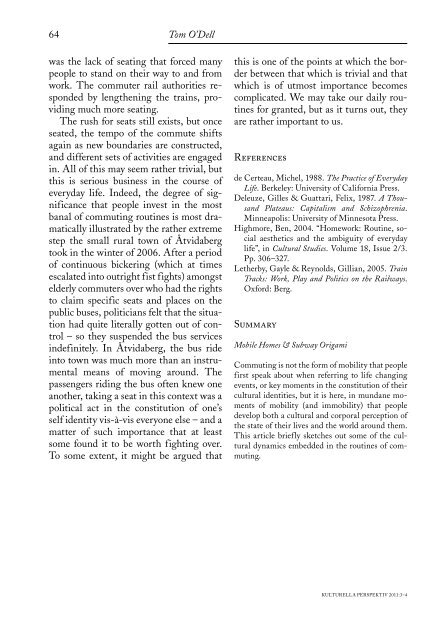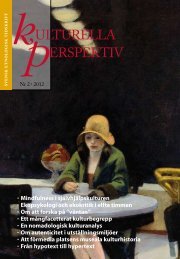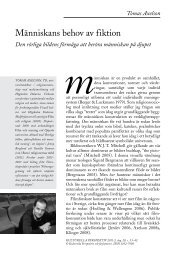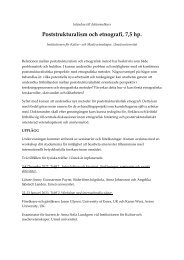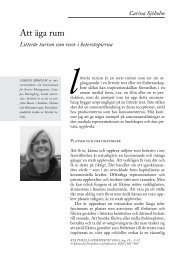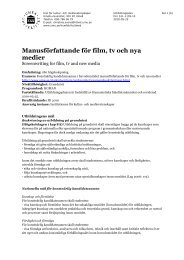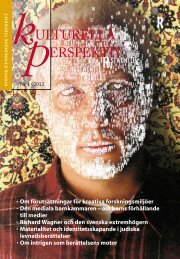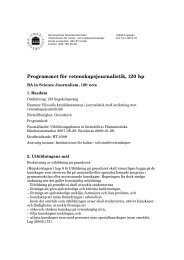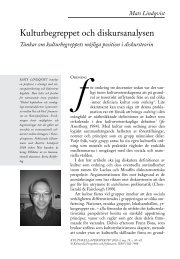Läs hela nr. 3-4 här - Institutionen för kultur och medievetenskaper
Läs hela nr. 3-4 här - Institutionen för kultur och medievetenskaper
Läs hela nr. 3-4 här - Institutionen för kultur och medievetenskaper
Create successful ePaper yourself
Turn your PDF publications into a flip-book with our unique Google optimized e-Paper software.
64 Tom O’Dell<br />
was the lack of seating that forced many<br />
people to stand on their way to and from<br />
work. The commuter rail authorities responded<br />
by lengthening the trains, providing<br />
much more seating.<br />
The rush for seats still exists, but once<br />
seated, the tempo of the commute shifts<br />
again as new boundaries are constructed,<br />
and different sets of activities are engaged<br />
in. All of this may seem rather trivial, but<br />
this is serious business in the course of<br />
everyday life. Indeed, the degree of significance<br />
that people invest in the most<br />
banal of commuting routines is most dramatically<br />
illustrated by the rather extreme<br />
step the small rural town of Åtvidaberg<br />
took in the winter of 2006. After a period<br />
of continuous bickering (which at times<br />
escalated into outright fist fights) amongst<br />
elderly commuters over who had the rights<br />
to claim specific seats and places on the<br />
public buses, politicians felt that the situation<br />
had quite literally gotten out of control<br />
– so they suspended the bus services<br />
indefinitely. In Åtvidaberg, the bus ride<br />
into town was much more than an instrumental<br />
means of moving around. The<br />
passengers riding the bus often knew one<br />
another, taking a seat in this context was a<br />
political act in the constitution of one’s<br />
self identity vis-à-vis everyone else – and a<br />
matter of such importance that at least<br />
some found it to be worth fighting over.<br />
To some extent, it might be argued that<br />
this is one of the points at which the border<br />
between that which is trivial and that<br />
which is of utmost importance becomes<br />
complicated. We may take our daily routines<br />
for granted, but as it turns out, they<br />
are rather important to us.<br />
References<br />
de Certeau, Michel, 1988. The Practice of Everyday<br />
Life. Berkeley: University of California Press.<br />
Deleuze, Gilles & Guattari, Felix, 1987. A Thousand<br />
Plateaus: Capitalism and Schizophrenia.<br />
Minneapolis: University of Minnesota Press.<br />
Highmore, Ben, 2004. “Homework: Routine, social<br />
aesthetics and the ambiguity of everyday<br />
life”, in Cultural Studies. Volume 18, Issue 2/3.<br />
Pp. 306–327.<br />
Letherby, Gayle & Reynolds, Gillian, 2005. Train<br />
Tracks: Work, Play and Politics on the Railways.<br />
Oxford: Berg.<br />
Summary<br />
Mobile Homes & Subway Origami<br />
Commuting is not the form of mobility that people<br />
first speak about when referring to life changing<br />
events, or key moments in the constitution of their<br />
cultural identities, but it is here, in mundane moments<br />
of mobility (and immobility) that people<br />
develop both a cultural and corporal perception of<br />
the state of their lives and the world around them.<br />
This article briefly sketches out some of the cultural<br />
dynamics embedded in the routines of commuting.<br />
KULTURELLA PERSPEKTIV 2011:3–4


